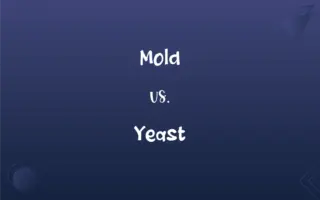Azeotropic Distillation vs. Extractive Distillation: What's the Difference?
Edited by Aimie Carlson || By Harlon Moss || Published on March 18, 2024
Azeotropic distillation involves adding a third component to create a new azeotrope, while extractive distillation uses a solvent to alter relative volatilities.

Key Differences
Azeotropic Distillation is the process used to separate components of an azeotropic mixture, which is a mixture that behaves like a single substance with a constant boiling point. By adding a third component, called an entrainer, a new azeotrope is formed with one of the original components, allowing for easier separation. On the other hand, in extractive distillation, a solvent is added to the mixture to selectively alter the relative volatilities of the components. The solvent preferentially binds with one component, making it easier to separate the mixture based on differences in boiling points.
Both methods aim to separate components that are difficult to separate by conventional distillation. Azeotropic distillation relies on forming a new azeotrope, while extractive distillation relies on changing relative volatilities with a solvent.
Azeotropic distillation is commonly used in the petrochemical industry and for separating azeotropes like ethanol-water. Extractive distillation is used in processes like the separation of aromatic compounds from non-aromatics.
Azeotropic distillation can be more complex due to the need to find a suitable entrainer and manage azeotrope formation. Extractive distillation may require careful solvent selection and recovery.
Comparison Chart
Principle
Uses an entrainer to form a new azeotrope
Uses a solvent to alter relative volatilities
ADVERTISEMENT
Application
Separating azeotropic mixtures
Separating components based on volatility differences
Solvent/Entrainer
Requires a third component (entrainer)
Requires a solvent
Complexity
May be complex due to azeotrope formation
Complexity in solvent selection and recovery
Industry Usage
Petrochemical industry, ethanol-water separation
Separation of aromatic from non-aromatic compounds
Azeotropic Distillation and Extractive Distillation Definitions
Azeotropic Distillation
A method to separate azeotropic mixtures using an entrainer.
Azeotropic distillation is used to separate ethanol and water by adding benzene as an entrainer.
ADVERTISEMENT
Extractive Distillation
A solvent-based distillation process for complex mixtures.
Extractive distillation is utilized to separate isomers, such as ortho-xylene from para-xylene, using sulfolane.
Azeotropic Distillation
A distillation process that forms a new azeotrope for easier separation.
The azeotropic distillation of acetone and methanol requires the addition of water as an entrainer.
Extractive Distillation
A process that separates components based on altered boiling points.
In extractive distillation, the addition of dimethyl sulfoxide facilitates the separation of benzene and cyclohexane.
Azeotropic Distillation
A process that relies on the formation of a ternary azeotrope.
In azeotropic distillation, the addition of hexane enables the separation of ethanol and water.
Extractive Distillation
A technique for separating azeotropes without forming a new one.
The extractive distillation of ethanol and water can be achieved using ethylene glycol.
Azeotropic Distillation
A technique to break azeotropic points by altering the composition.
Azeotropic distillation can separate isopropyl alcohol and water using cyclohexane.
Extractive Distillation
A method that uses a selective solvent to enhance separation.
Extractive distillation with aniline as a solvent is used to purify toluene from xylene.
Azeotropic Distillation
A separation method for mixtures with constant boiling points.
Azeotropic distillation is employed to purify ethanol from its azeotrope with water using toluene.
Extractive Distillation
A distillation technique using a solvent to change volatility.
Extractive distillation is applied to separate butanol from water using glycol as a solvent.
FAQs
What is extractive distillation?
Extractive distillation is a technique that uses a solvent to selectively alter the relative volatilities of the components in a mixture, facilitating their separation based on differences in boiling points.
What is azeotropic distillation?
Azeotropic distillation is a method used to separate components of an azeotropic mixture by adding a third component, called an entrainer, to create a new azeotrope for easier separation.
How does azeotropic distillation differ from extractive distillation?
Azeotropic distillation involves forming a new azeotrope with an entrainer, while extractive distillation uses a solvent to change the relative volatilities of the components.
What is an entrainer in azeotropic distillation?
An entrainer is a third component added in azeotropic distillation to form a new azeotrope with one of the original components, aiding in the separation process.
Is extractive distillation suitable for separating all mixtures?
Extractive distillation is suitable for separating mixtures with components that have different affinities for the solvent, but it may not be effective for all mixtures.
What is the role of a solvent in extractive distillation?
In extractive distillation, the solvent is used to selectively alter the relative volatilities of the components in the mixture, making it easier to separate them based on boiling point differences.
Can azeotropic distillation separate all types of azeotropes?
Azeotropic distillation is effective for many, but not all, types of azeotropes. The success depends on finding a suitable entrainer that forms a new azeotrope with one of the components.
What are some common applications of azeotropic distillation?
Azeotropic distillation is commonly used in the petrochemical industry and for separating ethanol-water mixtures.
How is the entrainer recovered in azeotropic distillation?
The entrainer is typically recovered through a separate distillation process after the main separation has been achieved.
What are some common applications of extractive distillation?
Extractive distillation is used in the separation of aromatic compounds from non-aromatics and in the purification of specific chemical compounds.
How is the solvent recovered in extractive distillation?
The solvent is usually recovered through a separate distillation or extraction process, which may involve additional steps to ensure its purity for reuse.
What are the advantages of azeotropic distillation?
Azeotropic distillation can effectively separate azeotropic mixtures that are difficult to separate by conventional distillation methods.
What are the challenges of extractive distillation?
Challenges include selecting an appropriate solvent, solvent recovery, and potential solvent contamination of the products.
How does the choice of entrainer affect azeotropic distillation?
The choice of entrainer is crucial as it must form a new azeotrope with one of the components and have suitable boiling point and separation properties.
How does the choice of solvent affect extractive distillation?
The choice of solvent is critical as it must selectively alter the relative volatilities of the components without forming a new azeotrope.
What are the advantages of extractive distillation?
Extractive distillation can separate components with close boiling points or azeotropic mixtures without forming a new azeotrope.
What are the challenges of azeotropic distillation?
Challenges include finding a suitable entrainer, managing azeotrope formation, and the complexity of the distillation process.
Can azeotropic distillation be used for all types of mixtures?
Azeotropic distillation is specifically used for separating azeotropic mixtures and may not be suitable for all types of mixtures.
Can extractive distillation be used for all types of mixtures?
Extractive distillation is most effective for mixtures where the components have different affinities for the solvent, but it may not be suitable for all mixtures.
What are some examples of entrainers used in azeotropic distillation?
Examples of entrainers include benzene, cyclohexane, and toluene, which are used to separate ethanol-water, isopropyl alcohol-water, and other azeotropic mixtures, respectively.
About Author
Written by
Harlon MossHarlon is a seasoned quality moderator and accomplished content writer for Difference Wiki. An alumnus of the prestigious University of California, he earned his degree in Computer Science. Leveraging his academic background, Harlon brings a meticulous and informed perspective to his work, ensuring content accuracy and excellence.
Edited by
Aimie CarlsonAimie Carlson, holding a master's degree in English literature, is a fervent English language enthusiast. She lends her writing talents to Difference Wiki, a prominent website that specializes in comparisons, offering readers insightful analyses that both captivate and inform.







































































